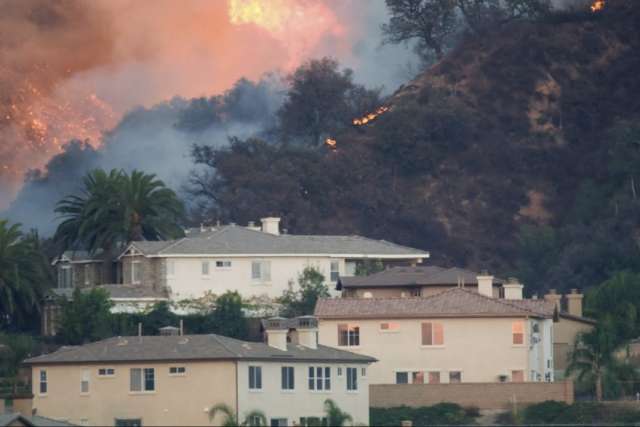Two UCLA Health pulmonologists have published a comprehensive review of the health consequences of wildfire smoke exposure, a more frequent concern in Southern California in recent years.
Co-authors May-Lin Wilgus, MD, assistant clinical professor, and Maryum Merchant, MD, associate clinical professor, both at the David Geffen School of Medicine at UCLA, focused on the harm of wildfire smoke to people with asthma and chronic obstructive pulmonary disease (COPD).
The review article, published recently in the journal Healthcare, noted that women and outdoor workers also experience worse effects.
Even healthy adults without risk factors should stay inside when air quality is poor because of smoke, Dr. Wilgus says.
“A big part of the danger of wildfire pollution is the intensity of the exposure,” Dr. Wilgus said. “The amount of pollution released can be manyfold higher than the routine air pollution we’re exposed to from other sources.”
Wildfires produce fine particulate matter, which spreads over areas much larger than the fire itself. It also penetrates deeply into the lungs.
“These super fine particles can travel into the smaller airways, causing irritation and inflammation, and can also be absorbed into the bloodstream causing inflammation in the entire body,” she said. “People with asthma and COPD are most sensitive to the effects on the smaller airways.”
SoCal wildfires
Dr. Wilgus became interested in smoke exposure after joining UCLA Health’s Ventura medical clinic in the fall of 2017. Soon after, the massive Thomas fire burned 281,893 acres in Ventura and Santa Barbara counties.
“I saw firsthand the effect of devastating air quality, evacuations and the aftermath, with an influx of patients who were experiencing asthma and COPD exacerbations,” she said. “Many patients described lingering symptoms for months.”
A year later, the Woolsey fire in Los Angeles and Ventura counties again caused flare ups of coughing, wheezing and shortness of breath among patients with chronic lung conditions.
“Wildfire smoke exposure leads people with underlying respiratory conditions to experience symptom exacerbation, ER visits and hospitalizations,” she said.
Dr. Wilgus said there’s a lot of data showing that wildfire smoke exposure causes an acute increase in respiratory symptoms, but more research is needed into the long-term consequences.
“It’s plausible that wildfire smoke exposure might lead to a decline in lung function,” she said.
Plan of action
Dr. Wilgus said people who may be more vulnerable to wildfire smoke should monitor air quality reports and be prepared for a flare of respiratory symptoms when the air quality is poor.
“People who have asthma or COPD should make sure they have enough medication and develop an action plan with their medical provider,” she said.
A plan might include using fast-action relief medications, commonly known as rescue inhalers, or seeking emergency care for severe symptoms.
Patients should look out for increased breathlessness and wheezing, a drop in oxygen saturation and escalating need for rescue inhalers.
When air is smoky, Dr. Wilgus said everyone should close doors and windows, turn on the air conditioner and use portable HEPA air purifiers.
Wearing a well-fitting N95 mask can filter out some fine particulates but it still isn’t safe to spend time outdoors. That leads to greater vulnerability for outdoor workers, Dr. Wilgus said.
People living in economically disadvantaged communities face challenges as well.
“Outdoor farmworkers have a really high exposure to wildfire pollutants,” she said. “The risk mitigation strategies that we recommend such as wearing a mask, not going outdoors, using a HEPA filter and evacuating, all these things are costly, and access can be restricted for people who have limited resources.”
In addition to children and older adults, women also appear more vulnerable to the effects of smoke exposure.
Dr. Wilgus said some epidemiological studies of wildfire smoke exposure in people with asthma and COPD have found that women experience more emergency room visits and hospitalizations than men.
“It’s not clear if women are more susceptible to the effects of wildfire smoke or are more likely to seek medical care for symptoms,” she said. “We do know that for COPD related to cigarette smoke exposure, women are more likely to develop COPD with a lesser smoking exposure and have a greater symptom burden than men.”
Even people without an underlying medical condition may experience symptoms from smoke exposure such as irritation of the throat, nose, and eyes, as well as a cough, breathlessness or headache.
“For any severe symptoms, certainly seek medical attention,” Dr. Wilgus said. “The most important advice is just to stay indoors.”





